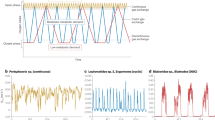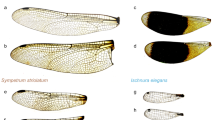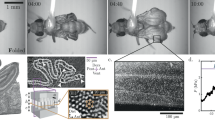Abstract
THE chief functions of the air sacs in insects may be listed as follows: (1) As suggested by John Hunter1, in an insect of fixed external dimensions they will assist flight by lowering the specific gravity. (2) They increase the volume of tidal air during respiration and so reduce the distance over which oxygen must diffuse to reach the tracheal endings2,3. Their ventilation may be effected by direct pressure from the body wall, as in the abdomen; but in the head, or other incompressible parts, collapse of the air sacs may be brought about by pressure transmitted via the hæmolymph4. (3) The flight muscles of many insects have large tracheæ, with elliptical cross-section, between them. The muscles are automatically ventilated during flight by the compression of these intramuscular air sacs5. (4) Even when the air sacs are of no great importance in ventilation they will serve to reduce the mechanical damping of the wing movements by the hæmolymph5. (5) The large air sacs in the front of the abdomen of Lucilia, Calliphora, etc., seem to play no essential part in respiration. They are distended with air, or collapsed, according to the state of other organs in the abdomen; in this way they ensure that the external form of the abdomen remains unchanged at all times6. (6) The air sacs of aquatic insects have a hydrostatic function. (7) The further function which is here proposed was suggested by observations on the adult Drosophila. When this fly emerges from the pupa the air sacs are collapsed and the body cavity contains a large amount of hæmolymph. The air sacs in this state are illustrated in Plate 1, Fig. 9 of a paper on tracheal injection7. By 24 h after emergence the air sacs are fully distended. They now occupy a large part of the body cavity in the head and thorax which was previously occupied by hæmolymph (Plate 1, Figs. 7, 11; Plate II, Fig. 5, 6, 7, 8)7.
This is a preview of subscription content, access via your institution
Access options
Subscribe to this journal
Receive 51 print issues and online access
$199.00 per year
only $3.90 per issue
Buy this article
- Purchase on SpringerLink
- Instant access to full article PDF
Prices may be subject to local taxes which are calculated during checkout
Similar content being viewed by others
References
Newport, G., Phil. Trans. Roy. Soc., 529 (1836).
Demoll, R., Z. Biol., 86, 45 (1927).
Wigglesworth, V. B., Biol. Rev., 6, 181 (1931).
Graber, V., Die Insekten (Munich, 1877).
Weis-Fogh, T., Proc. Fourteenth Intern. Cong. Zool., Copenhagen, 1953, 283 (1956).
Evans, A. C., Bull. Entomol. Res., 26, 115 (1935).
Wigglesworth, V. B., Quart. J. Micro. Sci., 91, 217 (1950).
Wigglesworth, V. B., J. Exp. Biol., 26, 150 (1949).
Author information
Authors and Affiliations
Rights and permissions
About this article
Cite this article
WIGGLESWORTH, V. A Further Function of the Air Sacs in some Insects. Nature 198, 106 (1963). https://doi.org/10.1038/198106a0
Issue date:
DOI: https://doi.org/10.1038/198106a0
This article is cited by
-
Cuticular modified air sacs underlie white coloration in the olive fruit fly, Bactrocera oleae
Communications Biology (2021)
-
Pneumatic smart surfaces with rapidly switchable dominant and latent superhydrophobicity
NPG Asia Materials (2018)
-
The antennal movement apparatus in the small tortoiseshell (Aglais urticae L., Insecta, Lepidoptera)
Zoomorphologie (1978)



